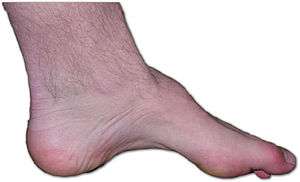Distal hereditary motor neuropathy type V
| Distal hereditary motor neuropathy type V | |
|---|---|
| Classification and external resources | |
| OMIM | 600794 |
Distal hereditary motor neuropathy type V (dHMN V) is a particular type of neuropathic disorder. In general, distal hereditary motor neuropathies affect the axons of distal motor neurons and are characterized by progressive weakness and atrophy of muscles of the extremities.[1] It is common for them to be called "spinal forms of Charcot-Marie-Tooth disease (CMT)", because the diseases are closely related in symptoms and genetic cause. The diagnostic difference in these diseases is the presence of sensory loss in the extremities.[2] There are seven classifications of dHMNs, each defined by patterns of inheritance, age of onset, severity, and muscle groups involved. Type V (sometimes notated as Type 5) is a disorder characterized by autosomal dominance, weakness of the upper limbs that is progressive and symmetrical, and atrophy of the small muscles of the hands.[3]
Signs and symptoms
Onset usually occurs within the first two decades of life, commonly in the teenage years or the twenties. Life expectancy is normal.

High arch of the foot (pes cavus) is common. Patients also have trouble controlling their hands, due to muscle loss on the thumb side of the index finger and palm below the thumb.[4] It is rare for a person with this disorder to lose the ability to walk, though changes in gait may occur later in life.[5]
Frequency of this disorder is unknown.[6]
Diagnosis
In an individual with dHMN V, electromyography will show pure motor neuropathy, patterns of weakness without upper motor neuron damage, in the hands. Tendon reflexes will also appear normal.[7] Clinical, electrophysiological, and pathological testing will show a lack of damage to sensory neurons, differentiating this disease from CMT.[8]
Genetics
dHMN V has a pattern of autosomal dominance, meaning that only one copy of the gene is needed for the development of the disease. However, there is incomplete penetrance of this disorder, meaning that some individuals with the disease-causing mutations will not display any symptoms.[3] Mutations on chromosome 7 have been linked to this disease. It is allelic (i.e., caused by mutations on the same gene) with Charcot–Marie–Tooth disease and with Silver’s Syndrome, a disorder also characterized by small muscle atrophy in the hands.[1][9] Another rare form of dHMN V is associated with a splicing mutation in REEP-1, a gene often associated with hereditary spastic neuroplegia.[10]
Treatment
Physical therapy is the predominant treatment of symptoms. Orthopedic shoes and foot surgery can be used to manage foot problems.[5]
References
- 1 2 Seo, Ah Jung; Park, Byung Sun; Jeong, Na Young; Kim, Doyen; Kim, Sunghoon; Park, Chan; Jung, Junyang; Huh, Youngbuhm (2014). "Adenoviral-mediated mouse model of motor impairment in distal spinal muscular atrophy type V". Animal Cells and Systems. 18 (5): 311–317. doi:10.1080/19768354.2014.950330. ISSN 1976-8354.
- ↑ Middleton, L. T.; Christodoulou, K.; Mubaidin, A.; Zamba, E.; Tsingis, M.; Kyriacou, K.; Abu-Sheikh, S.; Kyriakides, T.; Neocleous, V.; Georgiou, D. M.; El-Khateeb, M.; Al-Qudah, A.; Horany, K. (1999). "Distal Hereditary Motor Neuronopathy of the Jerash Type". Annals of the New York Academy of Sciences. 883 (1 CHARCOT-MARIE): 439–442. doi:10.1111/j.1749-6632.1999.tb08604.x. ISSN 0077-8923.
- 1 2 Rakočević-Stojanović, V.; Milić-Rašić, V.; Perić, S.; Baets, J.; Timmerman, V.; Dierick, I.; Pavlović, S.; De Jonghe, P. (2010). "N88S mutation in the BSCL2 gene in a Serbian family with distal hereditary motor neuropathy type V or Silver syndrome". Journal of the Neurological Sciences. 296 (1-2): 107–109. doi:10.1016/j.jns.2010.06.015. ISSN 0022-510X.
- ↑ "Distal hereditary motor neuropathy, type V". Think Genetic. 10 June 2016. Retrieved 5 November 2016.
- 1 2 Ito, Daisuke; Suzuki, Norihiro (2007). "Molecular pathogenesis of seipin/BSCL2-related motor neuron diseases". Annals of Neurology. 61 (3): 237–250. doi:10.1002/ana.21070. ISSN 0364-5134.
- ↑ Reference, Genetics Home. "distal hereditary motor neuropathy, type V". Genetics Home Reference.
- ↑ Antonellis, Anthony; Ellsworth, Rachel E.; Sambuughin, Nyamkhishig; Puls, Imke; Abel, Annette; Lee-Lin, Shih-Queen; Jordanova, Albena; Kremensky, Ivo; Christodoulou, Kyproula; Middleton, Lefkos T.; Sivakumar, Kumaraswamy; Ionasescu, Victor; Funalot, Benoit; Vance, Jeffery M.; Goldfarb, Lev G.; Fischbeck, Kenneth H.; Green, Eric D. (2003). "Glycyl tRNA Synthetase Mutations in Charcot-Marie-Tooth Disease Type 2D and Distal Spinal Muscular Atrophy Type V". The American Journal of Human Genetics. 72 (5): 1293–1299. doi:10.1086/375039. ISSN 0002-9297.
- ↑ Pareyson, Davide; Marchesi, Chiara (2009). "Diagnosis, natural history, and management of Charcot–Marie–Tooth disease". The Lancet Neurology. 8 (7): 654–667. doi:10.1016/S1474-4422(09)70110-3. ISSN 1474-4422.
- ↑ Dubourg, O.; Azzedine, H.; Yaou, R. B.; Pouget, J.; Barois, A.; Meininger, V.; Bouteiller, D.; Ruberg, M.; Brice, A.; LeGuern, E. (12 June 2006). "The G526R glycyl-tRNA synthetase gene mutation in distal hereditary motor neuropathy type V". Neurology. 66 (11): 1721–1726. doi:10.1212/01.wnl.0000218304.02715.04.
- ↑ Beetz, Christian; Pieber, Thomas R.; Hertel, Nicole; Schabhüttl, Maria; Fischer, Carina; Trajanoski, Slave; Graf, Elisabeth; Keiner, Silke; Kurth, Ingo; Wieland, Thomas; Varga, Rita-Eva; Timmerman, Vincent; Reilly, Mary M.; Strom, Tim M.; Auer-Grumbach, Michaela (2012). "Exome Sequencing Identifies a REEP1 Mutation Involved in Distal Hereditary Motor Neuropathy Type V". The American Journal of Human Genetics. 91 (1): 139–145. doi:10.1016/j.ajhg.2012.05.007. ISSN 0002-9297.